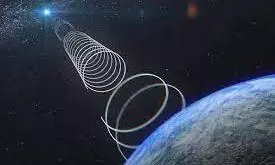
Radio signal from nine billion light years away reaches Earth
text_fieldsScientists in a first have found radio signals from a galaxy around 9 billion light-years away from the Earth. This is the first time a signal like this has been received from such a great distance.
The signals were detected by a unique wavelength called the hydrogen line or the 21-centimetre line. It is emitted by neutral hydrogen atoms. Atomic hydrogen emits radio waves of 21 cm wavelength and this can be detected using low-frequency radio telescopes like the GMRT. The 21 cm emission is said to be a direct tracer of the atomic gas content in galaxies.
Atomic hydrogen is the basic fuel needed for star formation. "When hot ionised gas from the surrounding medium of a galaxy falls onto the galaxy, the gas cools and forms atomic hydrogen, which then becomes molecular hydrogen, and eventually leads to the formation of stars," read the study published in Monthly Notices of the Royal Astronomical Society.
A statement from IISc said understanding the evolution of galaxies over cosmic time requires tracing the evolution of neutral gas at different cosmological epochs.
The telescopes that are currently in use have limited sensitivity which makes it nearly impossible to detect extremely weak radio signals. Until now, the most distant galaxy detected using 21 cm emission was with a look-back time of 4.1 billion years. A look-back time is the time elapsed between detecting the signal and its original emission.
Arnab Chakraborty, researcher at Trottier Space Institute of McGill University, said "the signal detected by the team was emitted from this galaxy when the universe was only 4.9 billion years old. The look-back time for this source is 8.8 billion years."
The signal was detected because it was magnified by the presence of another massive body, like an early type of elliptical galaxy between the target galaxy and the observer.
The statement from IISc said the atomic hydrogen mass of this particular galaxy is almost twice as high as its stellar mass. "These results demonstrate the feasibility of observing atomic gas from galaxies at cosmological distances in similar lensed systems with a modest amount of observing time. It also opens up exciting new possibilities for probing the cosmic evolution of neutral gas with existing and upcoming low-frequency radio telescopes in the near future."























